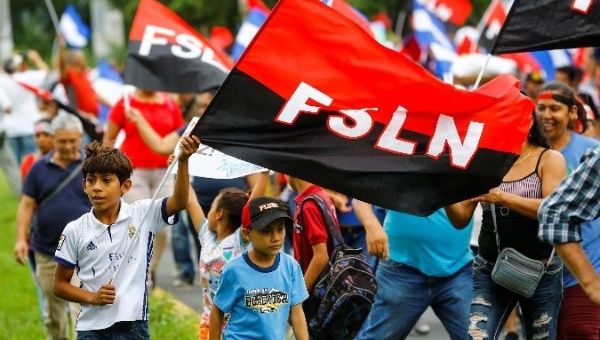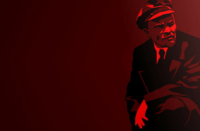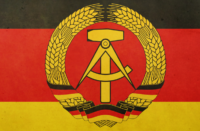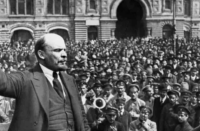After the victory of the right wing in the elections of 1990, the Sandinistas began a period of what they called “governing from below.” The new neo-liberal government increased the already massive foreign debt, cut wages, privatised industries, and slashed funds for health and education. In 2003 the former president Arnoldo Alemán was convicted of corruption, and he is now ranked among the most corrupt politicians in the world—which gives a snapshot of the type of people who took over from the Sandinista Front of National Liberation (FSLN).
The Sandinistas fought back, led strikes by workers, established Neighbourhood Councils of Citizens’ Power, and managed to build a people’s resistance to the capitalist measures that had seen Nicaraguans become impoverished, with electricity black-outs being common, all to service the debt the government had created.
While the FSLN had suffered some defeat when most of its middle-class parliamentary deputies left the party and created the Sandinista Renovation Movement (MRS), it managed to use its period out of power to rebuild its links with the poor.* After mass protests in 2005, the FSLN returned to power in 2007, beginning what they see as the second phase of the revolution.
Taking advantage of the new relationship with Venezuela—Nicaragua signed up to the Bolivarian Alliance for the Peoples of our Americas (ALBA) on Ortega’s first day as president—the FSLN had a reliable source of cheap energy as well as a new source of funds for social schemes while repaying the debt of the previous regime.
In the field of education they launched a new literacy campaign and abolished all fees. Their Zero Usury scheme provided micro-credit to small traders. Zero Hunger distributes farm goods to rural families, in order to make farms more self-sufficient. Both these policies are aimed more particularly at women.
The crime rate is now the lowest in Central America. The Councils of Citizens’ Power have been transformed from opposition vehicles into a method of direct democracy, much like the Cuban Committees for the Defence of the Revolution.
These policies brought more support for the FSLN among the poor, who benefited from them, but alienated the business classes, with which Ortega was forced to compromise in order to get into power. A major part of the FSLN’s strategy was a massive canal to be created across Lake Nicaragua, with Chinese help. This would have a great impact on the balance of forces in Latin America, countering the control by the United States over the Panamá Canal. While fitting in with the desire for an independent Nicaragua in a more multi-polar order in the region, such a capital investment project would allow the state to build up its industry, reduce its foreign debt, and allow Nicaraguans who work abroad to return home. Of course this also makes it a problem for the empire to the north.
In 2018 the International Monetary Fund demanded that Nicaragua change its social welfare law. While the IMF expected the government to comply, it did so by ensuring that the main losers were business interests, rather than the poor. This led to protests by middle-class students, backed by the right-wing media, which quickly developed into a copy of the Venezuelan opposition’s tactics. The protesters attacked and murdered police and Sandinista militants, attacked government buildings, and blamed the Ortega government.
After the protests died down and the barricades the opposition had erected were cleared, police and citizens discovered home-made rockets, petrol bombs, and other weapons. This, of course, did not stop the private media in Nicaragua, or the Western media, giving glowing reports about the opposition being liberal humanitarians.
The most important result from the failure of the attempted coup—besides the fact that it rallied the people even more strongly around the FSLN—is that it has broken the tactical alliance Ortega made with sections of the capitalist class. Nicaragua is mostly reliant on its “informal” sector—small farmers, family businesses, etc.; and, notwithstanding the economic damage caused by the coup attempt and the US sanctions, the state is forced to rely on its popular base.
The FSLN continues with its policies, with its new public housing programme, named after Bismarck Martínez, a Sandinista veteran who was tortured and killed during the attempted coup in 2018. It is among the world’s top ten countries for women’s representation in parliament.
The new phase of the revolution has managed to go beyond the first phase in an important way and to sever completely the link with the oligarchy. This is not what happens in a revolution that is moderating itself. While it may be tempting to say that Nicaragua should just nationalise everything, as Cuba did, it should be remembered that Cuba did so while having the backing of the Soviet Union. Much like Venezuela, what Nicaragua needs today is not dogmatic condescension or liberal ignorance but the support and solidarity—along with comradely criticism—of the working class, in Ireland and elsewhere.
*In 1996 allegations of sexual abuse were made against Daniel Ortega by his stepdaughter. While this is not the focus of this article, it needs to be mentioned, for ethical reasons.






